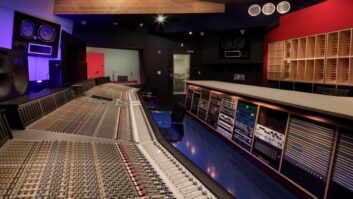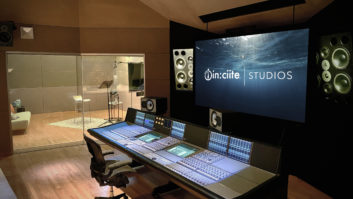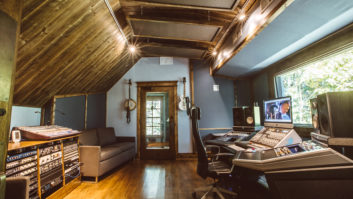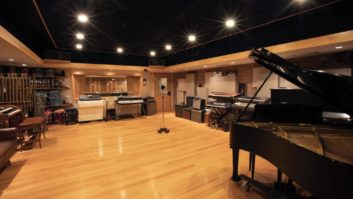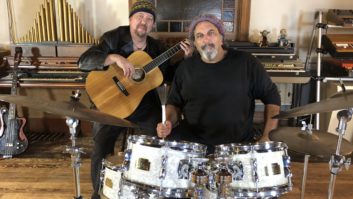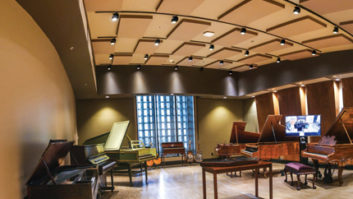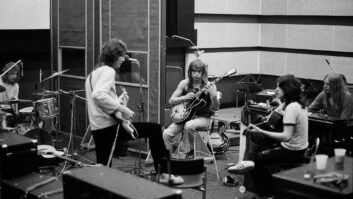
On the Cover: Allaire Studios
The studio on this year’s cover was designed by
architect/co-acoustician John Storyk and acoustician George Augspurger
(the first time the duo has worked together) and opened in September
2002. Set on a mountaintop estate in Shokan, N.Y., Allaire takes
advantage of its residential feel to attract high-end talent such as
Norah Jones and David Bowie.
The most impressive design feature of this facility is its
approximately 2,000-square-foot live recording room with 45-foot
vaulted ceilings. “The original turn-of-the-century interior
redwood beams and siding, as well as two large stone fireplaces, have
been left intact,” explains Storyk. “We wanted to create a large
environment that maintained full-frequency response accuracy while
allowing a significant amount of natural daylight into the room.
Full-height surround glass in the corners of the control room and wide
site-line viewing to the large tracking room accomplish this. In
addition, a new 650-square-foot control room with a SSL 9080 J console
has been constructed adjacent to the original building. ‘The Neve
Room,’ a second complete studio, is equipped with a Neve
8068.”
“The biggest acoustical challenge in the large control
room,” Augspurger recalls, “was to provide an accurate 5.1
mixing environment, yet at the same time, achieve even sound
distribution from front to back when using just the main speakers.
Custom monitor speakers were designed after [studio manager] Mark
McKenna had auditioned current commercial designs. Each cabinet has a
TAD high-frequency driver and multiple JBL 12-inch woofers: two woofers
for each surround speaker and four woofers for each main
speaker.”
Co-owned by photographer/musician Randall Wallace and Jackie
Wallace, the studio also offers Yamaha NS-10M, KRK Expose 7 and ATC
SCM-150 near-field speakers, Digidesign Pro Tools|HD and MIXPlus|24
systems, a heated pool, on-site chef and complete privacy.
Dave Matthews Band Studio

Trillium Lane
The Dave Matthews Band opened its own studio in January 2003, in the
Virginia countryside, to provide space for rehearsals, writing and
recording. The band, with keyboard player Butch Taylor and house
engineer Jeff Thomas, contracted architect’s studio bau:ton, led by
Peter Grueneisen, for the design and TEC:ton Engineering, headed by
Peter Maurer, for the technical design and systems integration. Ron
Lagerlof of Visioneering collaborated with TEC:ton on the project. A
large live room and two iso booths flank the control room, which boasts
an API Legacy console, Genelec main monitor system and Pro Tools|HD2.
Four skylights, positioned to reduce glare, puncture the pitched
roof.
Technicolor Creative Services
Abundant natural light floods Trillium Lane’s Great Room (shown), a
live recording and jam area attached to the control room. Designed by
Francis Manzella and opened in March 2002, this Bainbridge Island,
Wash., studio features a 5.1 control room with Pro Tools|HD and two
dedicated iso booths. There is a full selection of MIDI instruments,
popular plug-ins and microphones; monitoring is achieved through a
Martinsound MultiMax EX surround controller that feeds a 5.1 system
with Genelec 1031As and 192 subs. Smaller writing and programming rooms
round out this facility’s offerings.
M-Pire Studio
The digitally equipped, THX-certified theatrical mix stage at
Technicolor Creative Services (Glendale, Calif.) opened in April 2002.
Designed by Vincent van Haaff, the room boasts a Euphonix System 5, JBL
three-way theater system, five Pro Tools systems and a Lexicon 960; all
Pro Tools systems and disk-based systems link to a Studio Network
Solutions Fibre Channel A/V SAN Pro (now 120 seats). The
52×30-foot room is fully equipped to run 35mm, standard video or
high-definition projection.
Groove Addicts
Van Nuys, Calif.-based M-Pire Studio contracted Steven Klein to
design its new facility, which opened in March 2003. Notable features
include a clear line of sight from all points and floating floors
throughout. Featured equipment includes 48 tracks of RADAR II, Otari
Elite 48-track automated console, five Genelec 1031 monitors and a 1094
sub, plus an extensive mic closet. The project also included the design
of live and dry iso rooms and a large live tracking area.
Brooklyn Recording Studios
Recording and post-production facility Groove Addicts (Los Angeles),
comprising two studios and two sound-design rooms, was designed by Bret
Thoeny and acoustician George Augspurger. Opened on October 5, 2002,
the entire facility features independent floating floors. The control
room, built specifically for 5.1 monitoring, boasts a Yamaha DM2000 and
Pro Tools|HD3; monitoring is via 5.1 JBL LSR 28p, two JBL LSR-12p subs,
Yamaha NS-10s and Auratones. The studio to the right of the control
room allows for unobstructed listening in stereo or surround and clear
line of sight to the studio, iso booths and the control room’s 50-inch
plasma display. Three iso booths and a skylight round out this studio’s
features. Chief engineer Gerhard Joost chose and integrated all
equipment.
Crystalphonic
In November 2002, Brooklyn Recording Studios (Brooklyn, N.Y.) opened
the doors to its Walters-Storyk-designed, 2,500-square-foot studio and
control room. Featuring a vintage 60-channel custom Neve 8088 console,
Pro Tools|HD 192 and Genelec 1039A monitors, the room also boasts a
spectacular view of the Statue of Liberty, two iso booths and space for
up to a five-piece drum kit.

Sound on Sound, Studio D
Treasure Isle Recorders
Opened in January 2003, the Recording Architecture-designed,
four-room studio Crystalphonic (Charlottesville, Va.) includes an SSL
room (4064 E/G-Plus console, ATC mains), a 5.1 room (32-fader Digi Pro
Control, ATC surrounds), a post/edit suite (keyboards/modules from
Akai, Alesis, Korg, Moog, etc.), and a mastering room (ATC mains,
Egglestonworks Andra II monitors powered by Electrocompaniet NEMO
amps), each with substantial Pro Tools|HD systems. The entire facility
runs from a Studio Network Solutions’ fiber-optic SAN. The 30-foot-tall
tracking area (shown) contains an extensive collection of mics and
pre’s, and features a balcony and full-height diffusing “Acoustic
Trees” based on the designer’s Black Box technique of acoustic
control systems.
World Wrestling Entertainment
For all your Pro Tools|HD needs: Sound on Sound’s Studio D (New York
City) was designed by Larry Swist of Lawrence P. Swist Designs Group
for 5.1 surround mixing in Pro Tools via a 24-fader Pro Control surface
and Editpack. Monitoring is through custom LPS Designs mains with subs
(TAD and JBL components), Genelec 1031As and Yamaha NS-10M
near-fields.
Ironworks
With 23 years of recording experience under his belt, studio owner
Fred Vail redesigned the Nashville-based complex’s Studio A in November
2002. Sporting a new custom-made Trident Series 80 5 — which uses
24 vintage 80 Series modules and an additional 24 Oram Pro24 modules
— the studio also features RADAR 24, Pro Tools, Bryston power
amps, Tannoy 800A active speakers and DynAudio BM15 passive speakers.
Special care was also given to not change the overall acoustic sound of
the large, live room.
Burst@Creative Bubble
Wrestling is now popular enough that the WWE has opened its own
audio post and music-production facility in Stamford, Conn. The studio
was designed by Russ Berger Design Group and opened in April 2002.
Equipment of note includes: SSL SL9000 J Series board; Quested, Yamaha
NS-10M, Genelec 1031A and M&K monitors; and a healthy selection of
outboard gear, mics, keyboards and MIDI instruments, as well as a
Digidesign Pro Tools|HD3 system. Brazilian cherry floors and custom
waves of ceiling diffusers enhance sonic integrity. The live room
(shown) features earth-colored, split-face concrete block that supports
custom-radius cherry-wood diffusers.
Angel Mountain
Actor Keifer Sutherland, hot as can be right now with the success of
24, contracted Jeff Cooper Architects to transform this
L.A.-based 14,000-square-foot warehouse into a new recording studio.
The studio was constructed by Synergetics Inc., and had its grand
opening in November 2002. The control room, iso room, vocal booth and
main studio (shown) all open onto each other through double-paned
sliding glass doors to maintain line of sight throughout. The control
room houses a G Series SSL console, Studer 24-track recorder and RADAR
II digital recorder; monitoring is achieved through Genelec 1034Bs with
Bag End ELF sub and near-fields from Genelec and Yamaha, as well as
amps by Bryston and Hafler. Other equipment of note includes an
extensive collection of vintage guitars and mics.
Ocean Way Studio D
Offering sound design, TV and radio mixing, original mixing for
music compositions, sound effects, sound design and music libraries,
this New York City-based studio was designed by Studio Pacifica Ltd.
and opened in September 2002. The facility’s two audio suites and vocal
booths feature Pro Tools|HD with AVXL Option and Control|24 consoles;
an Avid Unity network ties the audio suites and vocal booths to the
video edit rooms. With a view of the Empire State Building and a
spacious living room feel, the audio rooms showcase custom ceiling and
back-wall acoustic treatment to provide a flat room response with a
large sweet spot to mix stereo and surround. The facility also boasts
Webcasting capabilities.
Blue Jay Studios
Angel Mountain (Bethlehem, Pa.) is an 18,000-square-foot
multi-studio complex with three 5.1-capable control rooms, a THX mix
theater, a scoring stage and other audio spaces. Designed from the
ground up by Pilchner Schoustal International Inc. (Toronto) in
conjunction with studio owner and president Gary Sloyer, the studio
opened in February 2003. The SSL XL 9000 K Series console lives in
Studio A, with five soffited, active Quested 412s, Pro Tools|HD and a
healthy collection of outboard gear. The scoring stage boasts
22-foot-high ceilings and three iso booths, including an enclosed
mezzanine space (shown); it can hold a 40-piece orchestra for large
ensemble recording and film scoring.
In January 2003, Hollywood-based Ocean Way opened its new Studio D.
Acoustical design was done in-house by Allen Sides. Featuring a new
84-input Neve 88R analog console with remote mic preamps and an inboard
stereo compressor, the room also features Allen Sides’ custom monitors
and one of the largest collections of outboard gear assembled.
In operation for 25 years, Blue Jay Studios (Carlisle, Mass.) was
recently purchased by Backstreet Boy Kevin Richardson and
writer/producer Marcus Siskind. The new owners commissioned Francis
Manzella of FM Design to overhaul the studio, which was completed in
July 2002. New equipment includes a custom Mad Labs Neve VR-72, custom
813-K monitors from John Klett of Technical Audio, and full Pro
Tools|HD systems for Studio A and Siskind’s private writing room. The
new acoustic design improves the accuracy of the control room’s bass
response and imaging, including the implementation of perforated metal
ceiling clouds, enlarged acrylic diffuser, additional bass trapping,
and new doors and windows.

2003 was a banner year for studio design: Try as we might,
we couldn’t possibly fit all of the hottest new rooms in the magazine.
Want to see more of the year’s top picks? Click
here.
